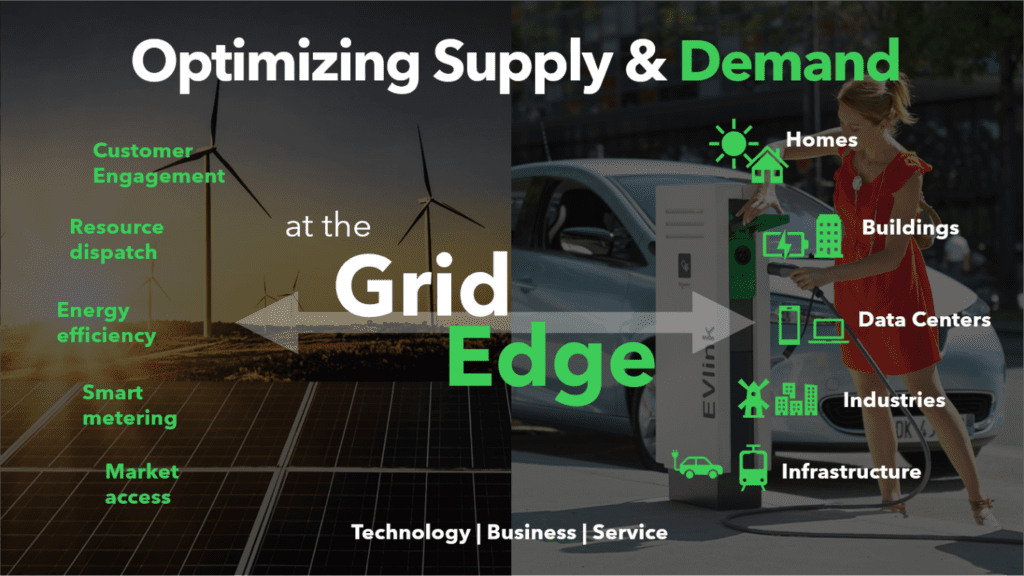Depending on what part of the world you live in, you are continuously exposed to terms like Grid Edge and Smart Grid. But the narrative is not the same everywhere – some regions speak of supply and demand real time optimization, and others are concerned with reliability and generating useful energy data. Are we all living different electrical grid realities? Possibly.
Let’s discuss the Smart Grid and Grid Edge, and let’s help you figure out which reality you are a part of.
Smart Grid
One of the first mentions of the term Smart Grid was in 2007 by the Department of Energy; through the American Recovery and Reinvestment Act, the U.S. government invested $4.5 Billion USD in grid modernization [1]. Smart Grid was the U.S. government’s and other energy stakeholders’ vision of modernizing the power grid through major investments in its infrastructure and communication. Before then, our electrical grid, in contrast to industries like transportation, had not seen any major transformation since its inception over 100 years ago.
Utility companies in the U.S. embarked on the journey to deploy Advanced Metering Infrastructure (AMI) over the last decade. One of the main goals of AMI is to create two-way communications between the end user of energy consumption and the Utility. Up to this point, automated meter readings provided ways to gather energy data from the meter, but onsite devices were not able to respond to dynamic price signals provided by the Utility. This new communication capability opened the door to automation and control technologies, along with new rate structures and business models.
Although we still have some way to go for a truly Smart Grid, its technology has expanded globally since 2007. The grid now has the ability to communicate to and from devices while reacting to weather or market conditions in near real-time. Today, nearly 60% of End Users in the U.S. have these AMI/Smart Meters, and the number is forecasted to increase to 81% by 2024 [2].
Grid Edge
The earliest use of the term Grid Edge can be traced back to Green Tech Media (GTM) in 2013 [3]. The then-new concept exhibited an increase in Rooftop Solar use at the end user level, AMI penetration, and a glimpse at newer technology like Battery Storage and Electric Vehicles (EV). As a result, the Grid Edge would bring to life the concept of Distributed Energy Resources (DER) and Prosumers. DERs can be identified at the Utility side (Supply side) with non-traditional generation projects like utility-scale solar or battery storage. At the end user side (demand side), rooftop solar, electric vehicles and storage technology have created the existence of prosumers, an energy user that also produces the energy that they consume.
In the U.S, success of Grid Edge projects varies by region due to factors like regulation, green or renewable energy mandates, AMI penetration, Utilities ambitions, and customer driven changes. Nevertheless, due to the global trends of Electrification, Decentralization, and Digitalization, Grid Edge projects are on the rise. Following the Electrification trend, the transportation sector expects 18 Million Electric Vehicles on the road in the U.S. by 2030 [4]. In Decentralization, currently there are 110GW of solar pipeline projects and 869MW of large-scale Battery storage installed in the U.S. [5]. Lastly, Digitalization shows how customers are changing, where studies show that 55% of Millennial Customers are interested in Energy Management, 44% are interested in solar, and 35% are interested in EVs [4].
Smart Grid and Grid Edge: Either or Both?

So, is Grid Edge really replacing the Smart Grid movement? The short answer is no. Both can be seen as different stages of the Digital Transformation our power grid is undergoing. All of us – utilities, energy providers, end users, and manufacturers – are paving our path together toward a true Digital Grid that is safe, reliable, and sustainable for everyone.
Please join me in the next article where we will discuss the industry drivers for Grid Edge, its benefits, and barriers of implementation.
At Schneider Electric, we are here to help you achieve your Grid Edge goals. No matter how early in the implementation process you are – managing a Demand Response or Energy Efficiency Program, optimizing in-front-of the meter or behind-the-meter DERs, or even gaining visibility to Microgrids and EV fleet management – Please visit our Utilities page for more information on our offers, and contact us. Contact us, we are here to help you succeed.
[1] U.S. Department of Energy (2009). Smart Grid Systems Report. Retrieved from https://www.energy.gov/oe/downloads/2009-smart-grid-system-report-july-2009
[2] Nhede, N. (2019, July 5). Smart meter penetration in North America will Reach 81% by 2024. Smart Energy International. https://www.smart-energy.com/industry-sectors/smart-meters/smart-meter-penetration-in-north-america-will-reach-81-by-2024/.
[3] Grid Edge (2013). Utility Modernization in The Age of Distributed Energy. Retrieved from https://www.truevaluemetrics.org/DBpdfs/Energy/SmartGrid/Grid-Edge-2013-web.pdf
[4] Deloitte Resources Study (2019). Energy Management: Balancing Climate, Cost and Choice.
[5] SEIA.org (2021). Major solar projects list. SEIA. https://www.seia.org/research-resources/major-solar-projects-list



